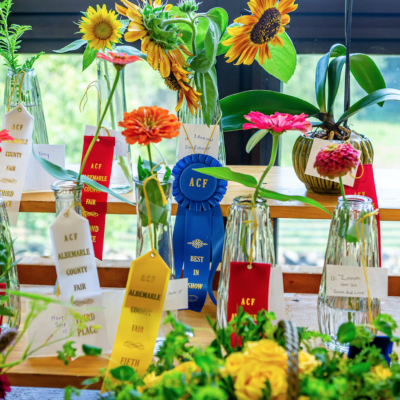“All things are numbers,” the Greek philosopher Pythagoras said, and in the wine world this often feels horribly true. Having recently returned from being a judge at the 17th annual State Fair of Virginia wine competition, I find myself thinking about the philosophy of wine tasting. Competition judges and wine critics both make it their business to tell you something about the quality of a given wine by slapping a number on it. How do we do this?
Someone slides a glass of wine in front of you and says, “Please assign this wine a numerical score.” What do you do? At the State Fair, we judges were told to break the wine down into five categories and assign points to each one: appearance (15), aroma (30), taste (30), finish (15) and overall impression (10).
 “Is there a perfect bottle of wine that all these bottles of wine are supposed to live up to?” was the best question at the 17th annual State Fair of Virginia wine competition. |
As a judge, it is my policy to automatically give every wine the full points for appearance. I think all wines are beautiful! Plus I can’t be bothered to spend time holding my glass up to the light, squinting at it and making pronouncements about its limpidity. Aroma and taste, on the other hand, should be easy, right?
Hmmm. What the hell does 30 points smell like?
Trying to score wines makes me think of Plato. Humans are constantly making judgments, and in order to do so we must have some standard of comparison. Looking at two circles, one drawn by a 3-year-old and one drawn by a math teacher with a drawing compass, most of us would say that the teacher’s circle is better. Obviously, Plato said, we are comparing it to knowledge we have of The Perfect Circle. Perfect circles, however, do not exist in this world, and that is where Plato starts babbling about The Forms, and people sitting around in caves.
My point, and I do have one, is that I always wonder what I’m supposed to be comparing each wine to. The Perfect Wine? When faced with a flight of Merlots, am I comparing them to the Platonic Form of Merlot? I’ve had a few Merlots, but I certainly don’t feel like an expert on the Merlot-ness of Merlot. This problem becomes especially acute when faced with, as happened at the State Fair, a flight of wines made from a grape I’ve never had before, namely Traminette. How many wine critics know what a perfect Traminette tastes like?
“Typicity” is what it’s called in the wine world, how close a wine comes to tasting like a “typical” wine of that grape or region. Standards like this, while important, often stifle uniqueness, as is the case with maverick Beaujolais producer Jean-Paul Brun. He was recently told by the INAO, the French governing body for wine, that his wine was “atypical” and could no longer be called Beaujolais. While this might not be problematic if the wine Brun was selling was white, made with Cabernet Sauvignon, and came in a six pack, Brun’s wine was “atypical” largely because it was naturally made, and therefore different from brand-name, mass-produced Beaujolais.
Maybe, I can hear you saying, you should just judge wines based on what you like best. Be more existential. Forget Plato, just go in there, taste wine, and score from the gut. Eventually, as the competition progressed, this is what I did, closing my eyes and summoning numbers from thin air. I was a maverick, judging wines by my own radical standards! I worried that I would end up being too different from the other judges. “My God,” they would say when they counted up the scores, “J. Tobias Beard is really out there! His ideas on minerality are so postmodern!”
Later, I got an e-mail from the organizer. “You did great,” she said, “you were only 1 percent off the rest of the judges for the overall competition…congrats!”
Screw Plato and Sartre. Another Greek philosopher, Diogenes the Cynic, got it right: “I like best the wine drunk at the cost to others.”





